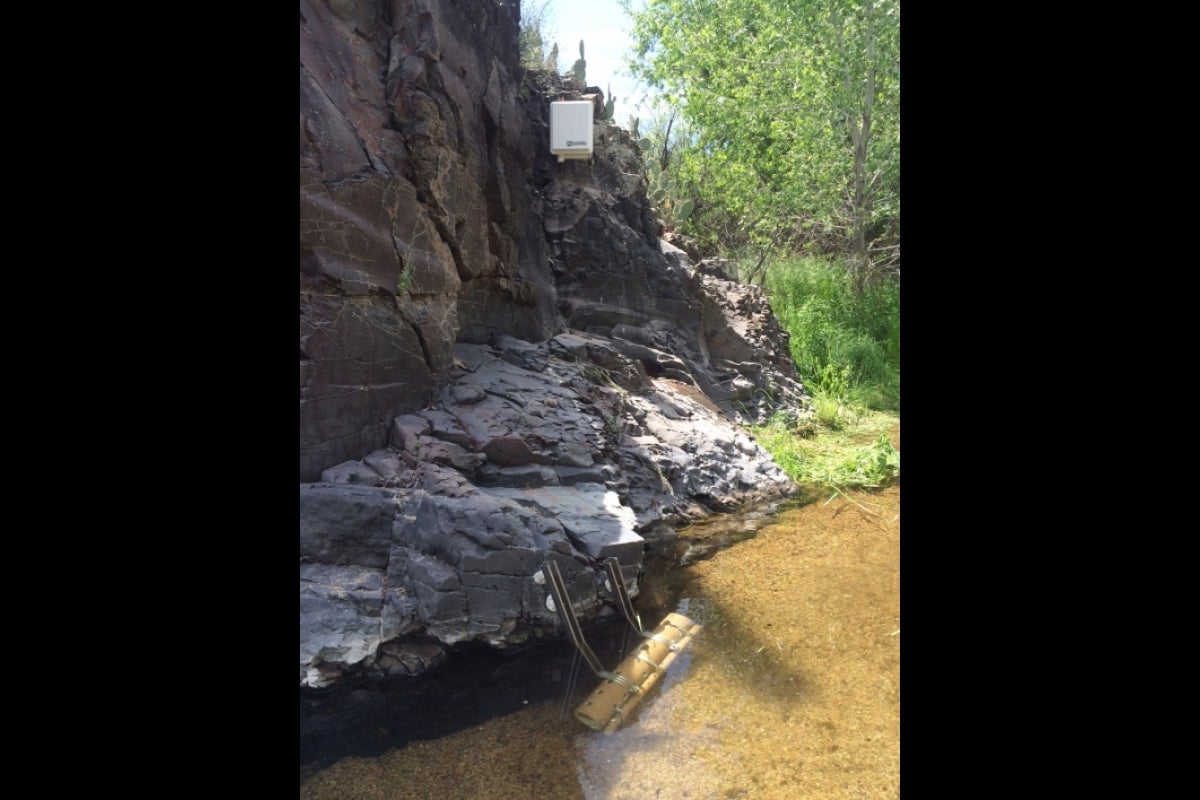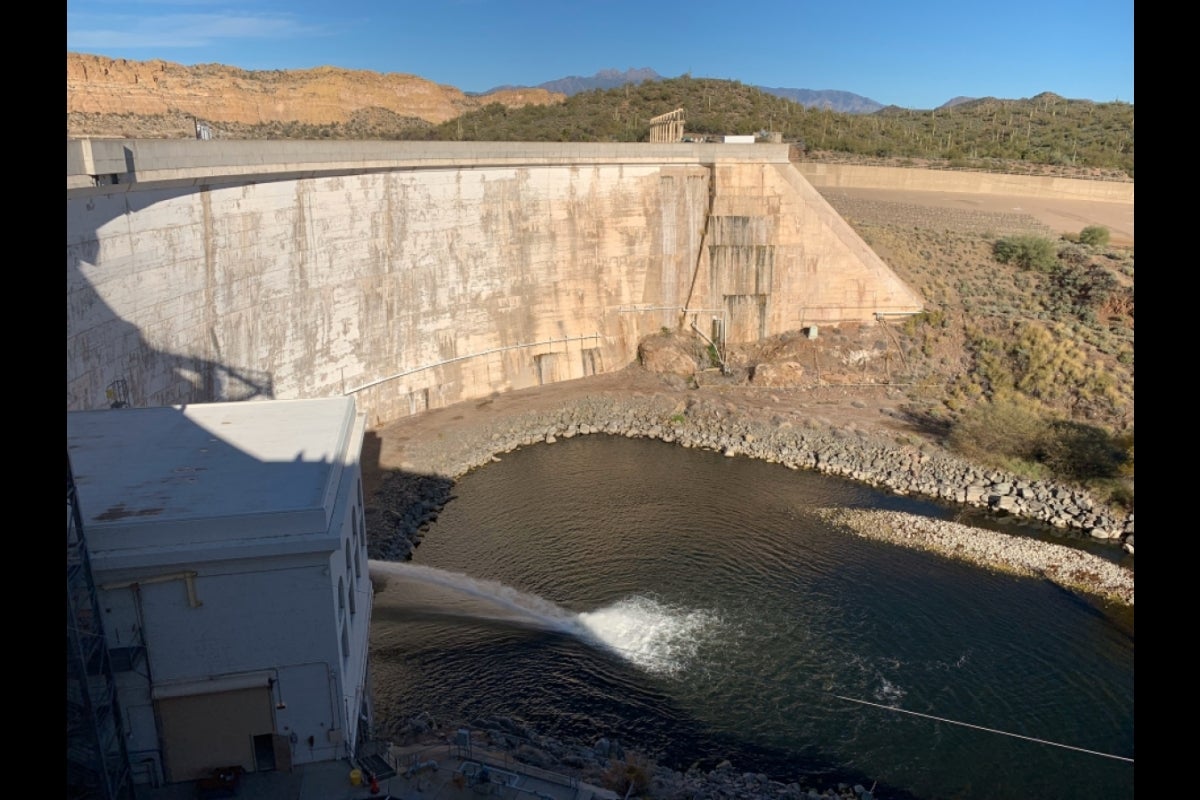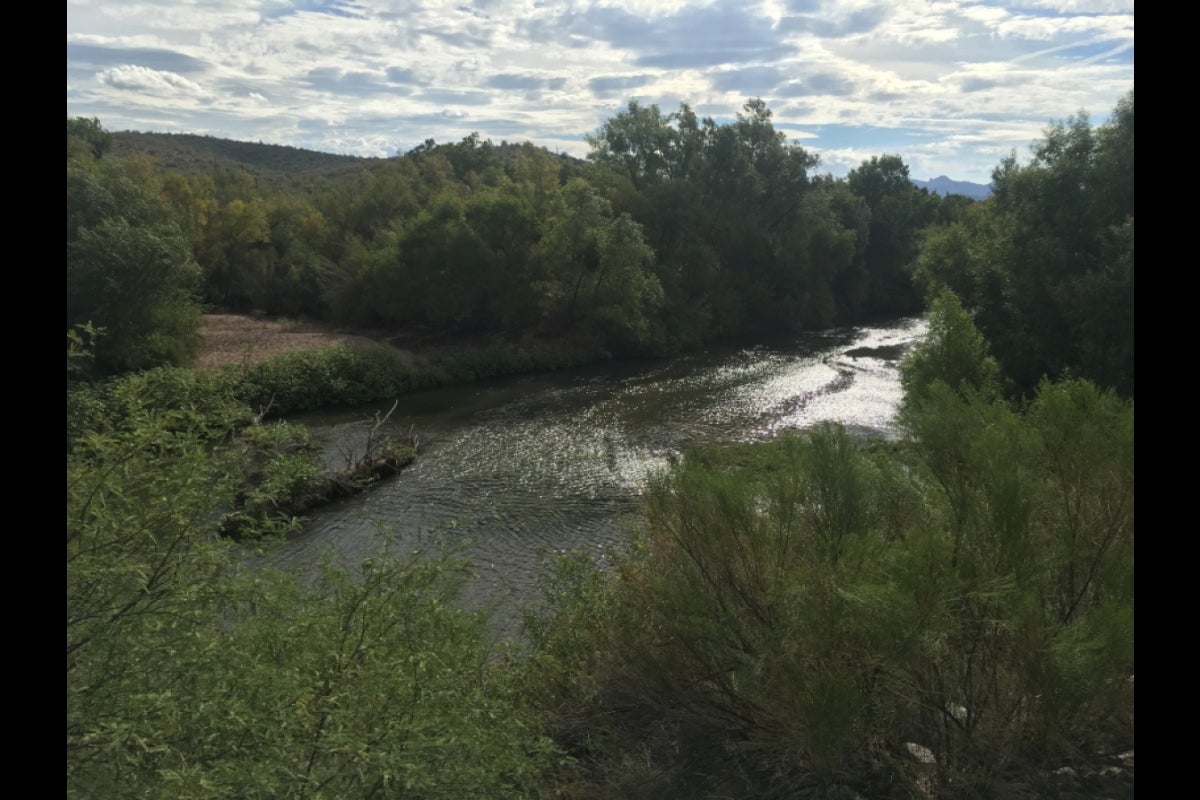Researchers show amount of sunlight and flow are master controllers for river ecosystems

Most of the cities in the world have developed because a river runs through them. Water not only sustains a thirsty city, removes waste, provides transportation and develops regional economies, but it also sustains the habitats of plants and animals to live, breed or feed a population.
Now, a new study has examined the ecosystem data on the pulse of more than 200 of our nation’s rivers and streams — a collection as varied as Arizona deserts, Puerto Rican rainforests or meandering rivers through farmland in the Midwest. A paper in the Proceedings of the National Academy of Science contributed by Arizona State University Regents Professor Nancy Grimm and led by her colleagues, Professor Emily Bernhardt and postdoc Phil Savoy of Duke University, has shown for the first time that the most important determinants of a river ecosystem’s metabolism — its health, productivity and ability to support aquatic life — come down to two master controllers: annual light availability and flow stability.
The new research findings may fundamentally change the way rivers are studied and improve our understanding of river ecosystem dynamics, with important ramifications for future river management, policy and climate change.
Terra firma
On land, temperature and precipitation have long been known to govern terrestrial ecosystem metabolism — the dynamics of organic production by plants and breakdown by all organisms — and help define the biomes of the world: aquatic, marine, grassland, forest, desert and tundra.
Scientists in land-based biomes can take continuous measurements using sensors, often mounted on towers, to provide accurate estimates of the metabolism and net carbon storage over large areas — factors important for understanding the health and biodiversity of a particular ecosystem.
“They put up towers and measure gases, particularly carbon dioxide, using sophisticated sensors,” said Grimm, an ecosystem ecologist. “They are able to model metabolism from the movement of carbon dioxide, which is consumed and produced by the living organisms on land, in and out of the ecosystem.”
This research has shown different terrestrial biomes are distinguishable by their annual patterns of temperature and precipitation.
By contrast, streams and rivers have been considered under a “one-size-fits-all” approach, often lumped into a single category: freshwater.
“Yet we know streams and rivers and lakes in different contexts vary tremendously,” said Grimm, a Regents Professor in ASU's School of Life Sciences, the Virginia M. Ullman Professor of Ecology and a Distinguished Global Futures Scientist.
“And so, we were just thinking, wouldn't it be great to develop some kind of mechanism to understand what distinguishes streams across these contexts; what makes them tick, really.”
Data by hand
Until recently, a main limitation was the lack of data. To understand a river’s health meant scientists had to pull on their waders and boots to collect field samples, which could be challenging, depending on the weather conditions.
“You had to go and collect samples by hand,” said Grimm. “And I did a lot of this as a graduate student, collecting samples and doing titrations to actually measure dissolved oxygen, and then using the change in oxygen throughout the day to calculate the rates of metabolism.”
Recently, on one of the first mild days in February, Duke's Professor Bernhardt and her stream ecology team demonstrated this by donning their hip waders and venturing out to the sycamore-lined banks of New Hope Creek.
The creek snakes its way through parts of Chapel Hill and Durham before emptying into Jordan Lake, the main supply of drinking water for central North Carolina.
Bernhardt waded into the shallow stream and dipped a gas sensor into the water. She and colleagues have been monitoring fluctuations in oxygen and carbon dioxide that occur as these gases are taken up and released by algae, insects, fish and other stream organisms while they go about the business of life: photosynthesizing, growing, digesting and decomposing.
“This ‘breathing in and breathing out’ of all the organisms living in a river is sort of the pulse of a stream,” Bernhardt said. “It's a fundamental measure of the energy going in and out of the system.”
But without adequate sensor technologies, scientists were limited in studying how variations like changes in dissolved gases may affect a river’s health and ability to support aquatic life. Traditionally, such studies have relied on measurements of a small number of streams taken over a few hours or days — essentially a snapshot. The difficulty is that irregularity and upheaval are the norms for streams, said former Duke postdoc Savoy.
Streamflow can change from day to day and even minute to minute with seasons and storms. Organisms living in the river must contend with flows that range from a torrent to a trickle.
“On any given day, you can go down to your local creek, and it might be dry, or it might be flooding over the banks,” Savoy said.
“River managers didn't use whole-ecosystem measures like metabolism as much as they used sampling invertebrates, for example,” said Grimm. “But now, we can actually get some understanding of the productivity and respiration (metabolism) rates of these rivers.”
The pulse of a river
Recently, there has been a period of rapid innovation in aquatic sensor technologies.
Now, scientists can continuously measure gases like oxygen and carbon dioxide dissolved in river water.
“In streams, this works well because the concentration of the dissolved gases changes when they are consumed or produced by biota,” said Grimm. “We can measure the changes in oxygen over a 24-hour period, and we can calculate how much photosynthesis is going on during the daylight hours and how much respiration is going on all the time.”
Scientists can automatically track stream vital signs 24 hours a day, seven days a week, over the course of weeks and months.
“It's like having your pulse taken once at the doctor’s office versus wearing a Fitbit,” Bernhardt said.
The data are uploaded to a public web portal where anyone can visualize or download it.
“And because we're doing this in a stream, it's measuring the oxygen dynamics of the entire ecosystem — everything that’s produced and consumed. We call this continuous record of stream metabolism the stream pulse.”
The available light
A few years ago, Grimm, Bernhardt and their colleagues wondered whether our nation’s rivers and streams couldn’t be placed into distinct categories that reflected their metabolism, similar to scientists’ understanding of land biomes.
“We have orders of magnitude more data than we ever had before,” said Grimm. “And we can begin to look at differences among streams, differences according to stream size or differences according to how much light the stream receives.”
So, the stream pulse team has performed a comprehensive analysis of river health from an examination of a large dataset of annual patterns of ecosystem productivity and respiration (metabolism) for 222 U.S. rivers. They attempted to tease out which were the most important drivers of a river ecosystem among the factors that are important to a river’s health: temperature and precipitation, but also light, chemistry and river flow.
First, through the global FLUXNET dataset derived from tower measurements, the researchers examined metabolic regimes in comparison with those collected for terrestrial ecosystems.
Overall, they found that the timing of peak annual river ecosystem productivity and respiration varied widely across the rivers. Some rivers had peak rates in nearly every month of the year, while many rivers had no annual peak. Many rivers saw their highest productivity in the spring, while more than 20% of the rivers have their highest respiration in the autumn or winter. This large variation suggests that river ecosystems have weak metabolic seasonality and lack the distinctive “growing season” peak in productivity observed for most terrestrial ecosystems.
But what were the driving forces behind the data?
What they found is that in contrast to land biomes, for rivers, the most important controls are annual light availability and flow stability.
“We can show for the first time that it is generalizable,” said Grimm. “Across all of these streams that we measured across the continent, even in sunny Arizona, light is absolutely critical.”
The amount of light coming into the stream can be affected by not only the annual number of sunny days in a region and seasonality, but also by the fact that some streams are heavily shaded by the surrounding forest or built environment.
Bernhardt’s team pointed out how much the light varied in North Carolina’s New Hope Creek during their recent field research, where her lab was collecting mayflies and other bugs. There, she pulled up a fistful of fallen leaves and a rock covered in a green-brown goo called periphyton — a mix of algae and microbes that clings to rocks and twigs in the streambed.
“This is the base of the food web,” Bernhardt said. “A lot of bugs make a living off these.”
Periphyton captures energy from the sun and uses it to grow. Insects, snails and mussels feed on the periphyton, and fish hunt and consume the insects.
What happens to stream life will likely depend on how human activity changes the amount of sunlight that reaches the water, and the stability of flow, the study authors report.
At New Hope Creek, leafy sycamores, beeches and sweetgum trees shade the edges for much of the year, forming a canopy that limits the light that can reach the narrower stretches of the stream.
But climate change-caused shifts in rainfall — intense droughts or flash floods — can dry out or blast away the algae and other organisms that form the base of the food web, Bernhardt said.
On this day, the sun-dappled water gurgling over rocks and riffles made for a placid scene.
“But three weeks ago, it was raging,” Bernhart said.
Rolling down the river
The stream pulse team found that those raging or placid waters were the second master controller of a river’s pulse: the amount of river flow. Flow stability measures how often rivers are disturbed — think of the two extremes being severe drought or torrential floods — ones that Arizona’s rivers are often subjected to.
“Disturbances are big here in the Arizona streams,” said Grimm.
Streams in the Colorado River Basin, Sedona’s Oak Creek and the nearby Verde River were some of the Arizona streams included in the study.
“It’s probably one of the reasons why you don't see them being as highly productive as we expected,” said Grimm. “I think these systems are subject to very big extremes between low flow and high flow, and that's because you get an all-or-none effect with precipitation. This is one of the characteristics of streams and rivers in this region. A lot of the water from a rainstorm runs off over the surface of the desert and produces flash floods. We have our monsoon season, so just when you're thinking it could be really productive because of the high light, you can get these floods that will come along and just wipe everything out.”
In addition, to protect populations from flooding or to provide electricity to a power-hungry region, many rivers are no longer free-flowing, having been confined by levees and dams. This also affects the river metabolism, as well as many aspects of ecosystem health.
“Interrupting the natural flow regime has huge implications,” said Grimm. “From all the way along the river, but also at the receiving end where, for example, in the Mississippi River, you no longer have delta formation at the Gulf of Mexico.”
A new river view
Based on their data, Bernhardt, Grimm and the stream pulse team developed a new categorization scheme of four main controllers, from highest to least productive:
- Bright and stable.
- Bright and stormy.
- Dark and stable.
- Dark and stormy.
“I mean, I think the thing that's really interesting about this is that we see these master controlling variables, which for rivers are different than they are for terrestrial systems,” said Grimm. “And so, we need to pay attention to these variables if we want to maintain systems in some kind of a state — whether it’s their natural state or if we want to think about restoration, or if we want to think about even the creation of systems that are highly managed by people. We would do well to pay attention to those master controlling variables.”
And if the cities of the future still want a river running through them, Grimm’s newly identified master controllers of river ecosystems will need to become better managed to withstand the growing challenges of the built environment, population growth and climate change.
“Compared to land biomes, central to the productivity of a river ecosystem is the understanding that these are important living ecosystems that provide services for us as a human population,” Grimm said. “Rivers are not just gutters; they are living ecosystems with important biota in them. They're not all the same, and vary tremendously from place to place.”
And as Norman Maclean once wrote in his famous novella: “Eventually, all things merge into one, and a river runs through it.”
This research was supported by the U.S. National Science Foundation (1442439, 1834679, 1442451, 2019528, 1442140, 1442467, 1442522, 1624807) and the U.S. Geological Survey. Data publicly available at https://data.streampulse.org/
More Science and technology

Breakthrough copper alloy achieves unprecedented high-temperature performance
A team of researchers from Arizona State University, the U.S. Army Research Laboratory, Lehigh University and Louisiana State University has developed a groundbreaking high-temperature copper alloy…

4 ASU researchers named senior members of the National Academy of Inventors
The National Academy of Inventors recently named four Arizona State University researchers as senior members to the prestigious organization.Professor Qiang Chen and associate professors Matthew…

Transforming Arizona’s highways for a smoother drive
Imagine you’re driving down a smooth stretch of road. Your tires have firm traction. There are no potholes you need to swerve to avoid. Your suspension feels responsive. You’re relaxed and focused on…









